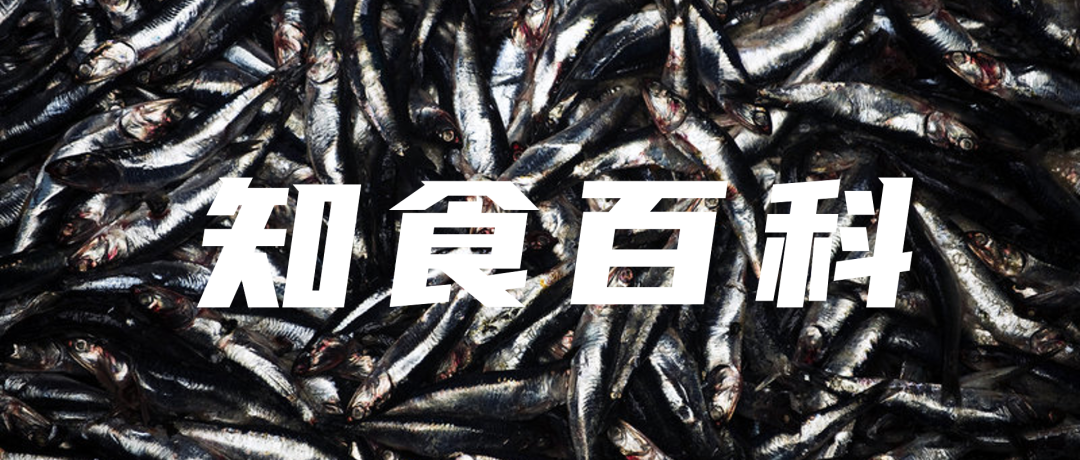
8 June, World Oceans Day.
Covering more than 70 percent of the Earth's surface, the oceans are a vast reservoir of resources.
More than one billion people worldwide rely on seafood as the primary source of protein [1]. At the same time, one billion people depend on fisheries for their livelihoods [2]. Seafood is also the most heavily traded food group in the world [3].
But if someone tells you that the fish you eat or the canned food you feed your cat or chicken provided by fishermen who may be slaves at sea. How would you feel?
In the third issue of the Food Literacy Encyclopedia, let's retrace the seafood supply chain and follow the documentary "Ghost Fleet", coming to understand fishery workers on the spreading sea, exploring their lives, and discovering the truth about food.
Boon-Mee* wandered the noisy streets of Bangkok. He wanted a girl to spend the hot, humid evening with. It was the last thing he remembered from the land.

* Boon-Mee is the pseudonym used by this writer to refer to a real person in the documentary -- a young man.
When he woke up, the bedroom was shaking. For a second, perhaps, Boon-Mee thought it was some kind of fun room. A salty breeze blew in, and he got up to find that the only color outside the window was the endless shimmer of the sea and that he was trapped on a fishing boat!
Thailand is one of the world's largest fishery exporters with seafood accounting for one-fifth of all Thai food exports [4]. More than 60 percent of production comes from marine fishing [5], which relies on a large number of fishermen at sea. The labor shortage has led the industry to acquire fishermen by any means necessary and to "keep" them -- to lock them in prison on the blue sea!
According to the 2019 data from the Thai Fisheries Department, there are more than 70,000 foreign immigrants among the more than 135,000 commercial fishing boat crews.

Image credit: Adam Dean for The New York Times
Tun Lin, a young Burmese boy, came to Thailand at the age of 15 or 16 to make a living, but he struggled to find a job. Finally, someone introduced him to a "factory.”
He thought he would finally stop starving, but that was not to be. "They locked him up, photographed him, made him a fake passport he had never seen before, and gave him a new name ...
Tun Lin was then taken to a fishing boat and never saw land again for the next 11 years.
Chicken farms, pig farms, shrimp processing plants, fish canning factories...various job scams have led to many people becoming fishing slaves. A few jumped into the sea to escape and swam back to land, while many more were swallowed up by the sea with no bodies left.
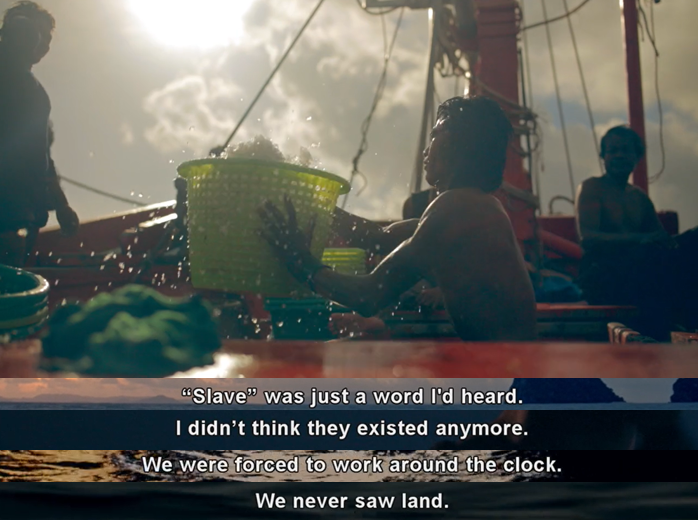
It is an unbelievable and unacceptable fact that today, there are still people who can become slaves overnight. The sea, far from where we live, is navigated by modern slavery.
It is difficult to estimate how many fishermen can survive in this situation. Still, a 2017 study showed that people trafficked almost 38% of fishermen who traveled from Cambodia and Myanmar to Thailand between 2011 and 2016 into fishing boats, and 76% became enslaved by debt bondage before they started working [6].
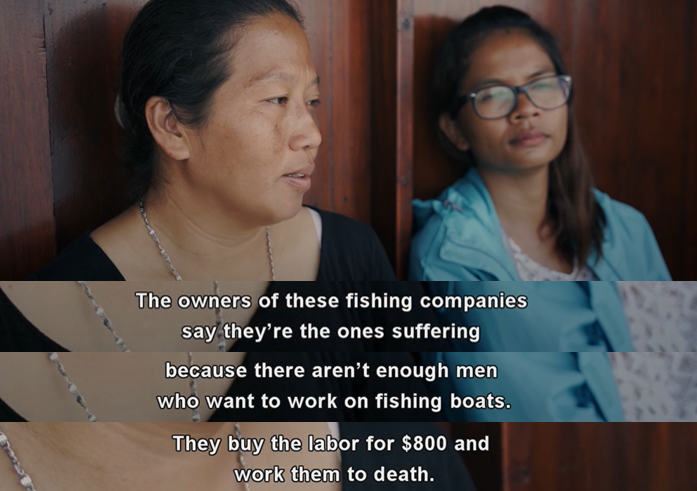
Fishery slaves are not only unpaid but also in debt - paying "black agents" to find work, and captains who burden slaves with more debt on the grounds that "it costs money to buy you," and who see them as nothing more than fishing tools.
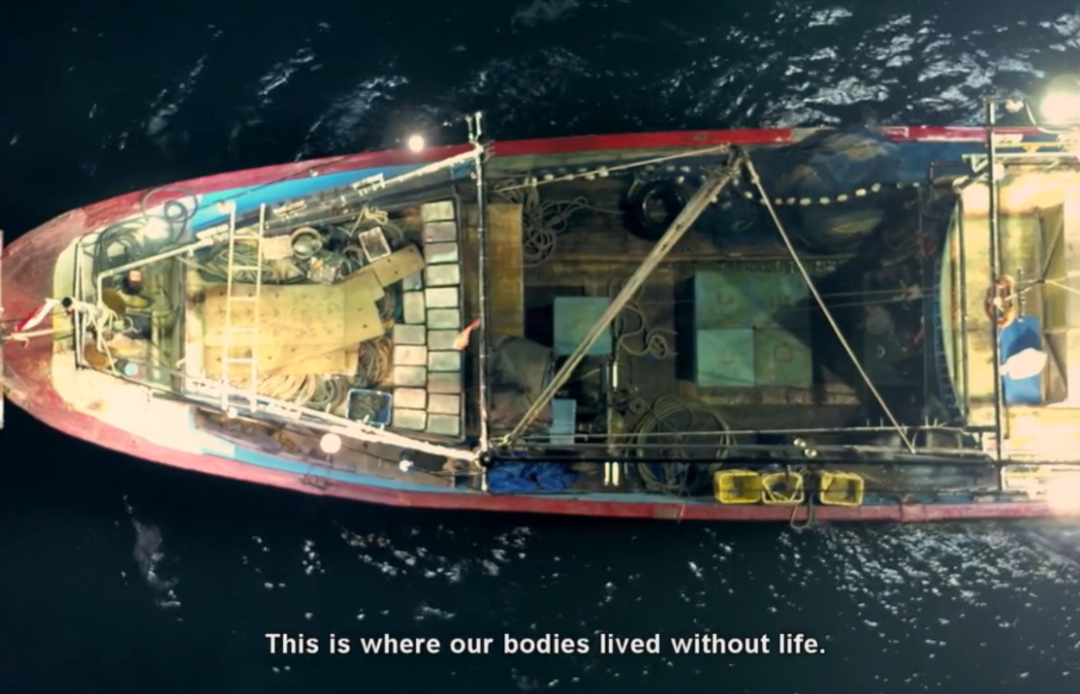
The fishing boats floating in the middle of the sea are entirely isolated from the rest of the world. Only the mothership would come once every three months to supply the fishing boats with food and fuel and take away their outputs. The slaves, however, lived in dilapidated fishing boats, unable to see the light of tomorrow.
On the fishing vessel, the captain is the sole authority. Partly as a defense against pirates, the captain is armed with guns. Guns also act as a deterrent to the crew, and although crew "uprisings" do occur, they rarely succeed [7].
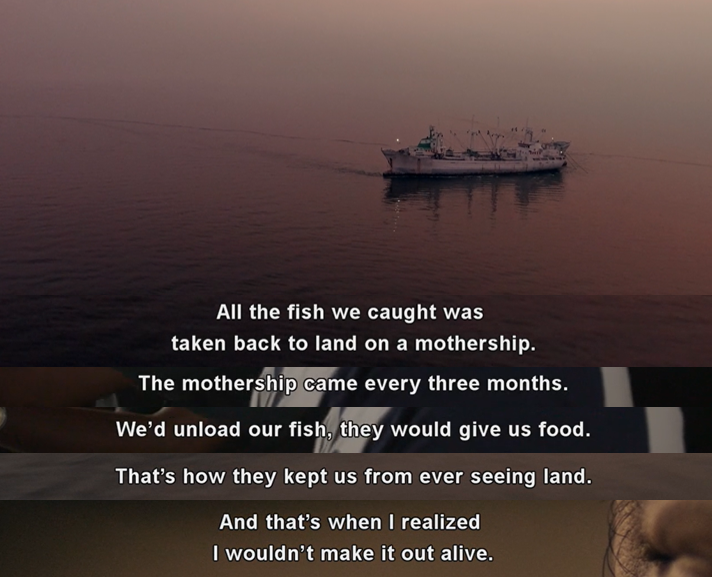
A UN study interviewed 50 Cambodians who had been trafficked to Thai fishing boats. Twenty-nine of them had witnessed the murder of crew members by the captain or his subordinates [7].
Regardless of wind, rain, or sun, the crew is forced to work 18-20-hour days. If they feel sleepy and want to nap, the captain will give the crew medicine or splash hot water to wake them up and keep them working. If they do not obey, they will be punished with blows and whips. Sailors are killed, starved to death, or even stuffed alive into crates and thrown to the bottom of the sea.
Not just fishery slaves, all fishery workers need to face this situation -- dangerous working conditions.
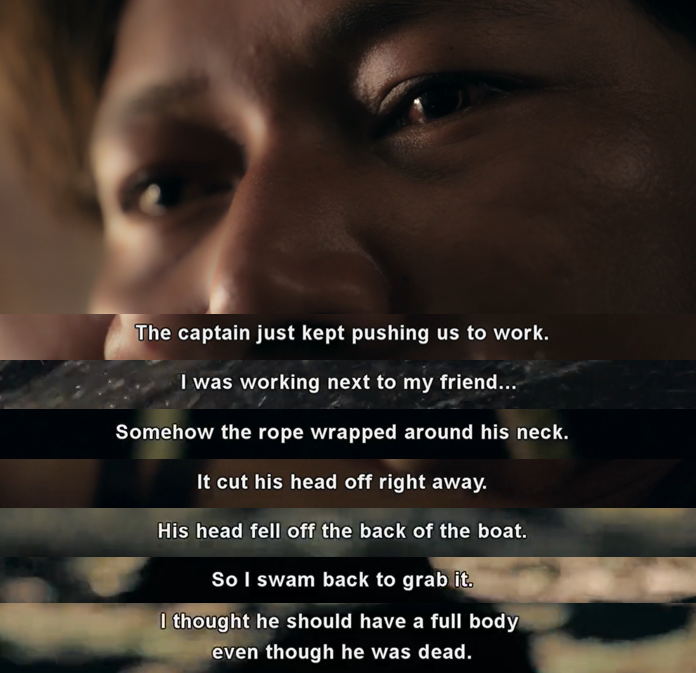
One sailor who was lucky enough to be rescued after five years in slavery and recalled seeing the crew's necks snapped off by a fast-moving rope in a winch and their heads dropped into the sea. He jumped into the sea to grab the head, not wanting to leave his companions dead without a full body.
We can't help but wonder what the roots of this modern form of slavery are?
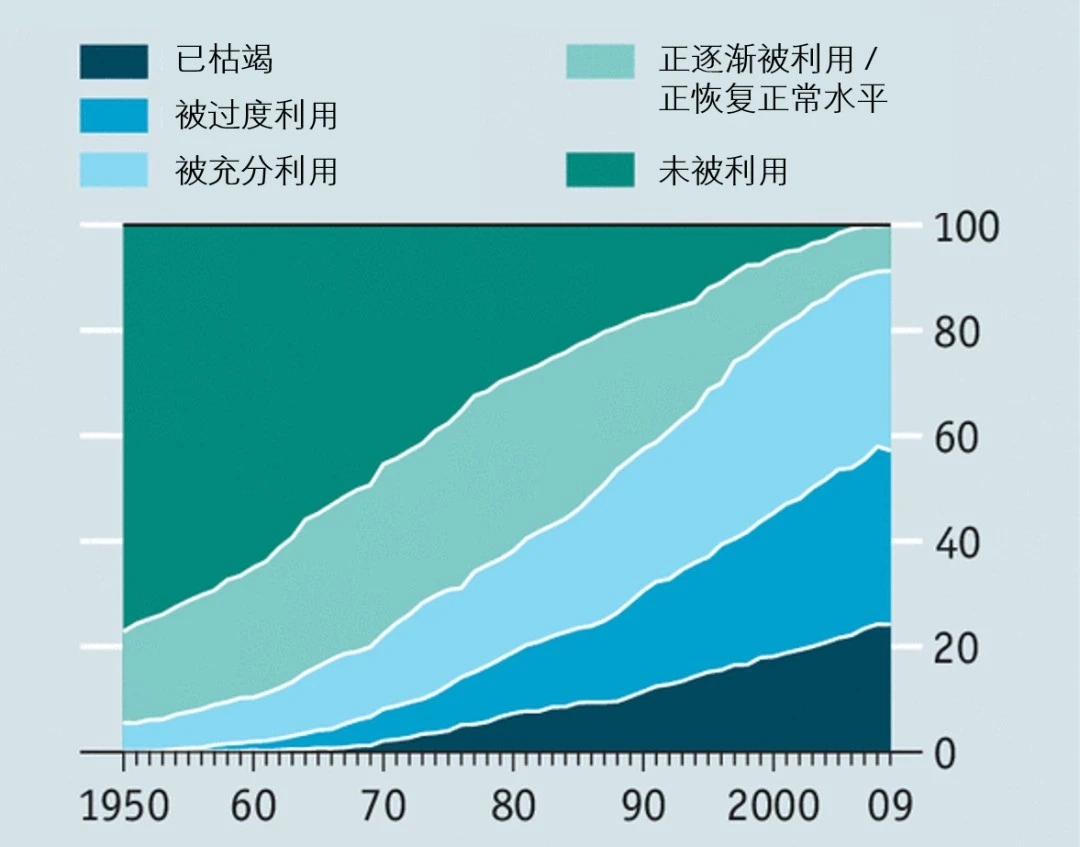 Global fishery resources [8]
Global fishery resources [8]
Human overfishing has left the coastline bereft of fish. In recent years, the total catch has shown a stable or declining trend.
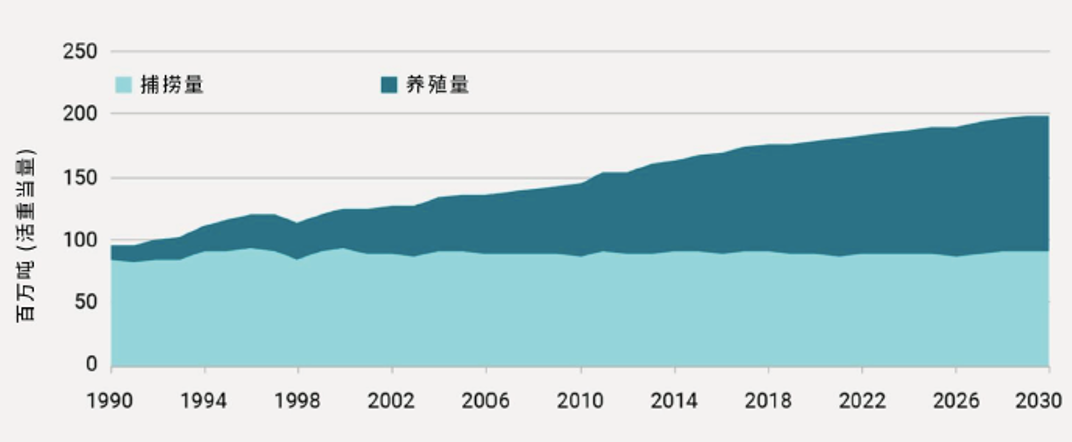
1990 – 2030 Global fishing and aquaculture yields [9]
To continue fishing, boats have to sail further out to sea, which means more fuel consumption. Today, the fuel cost accounts for 60% of a fishing vessel's total revenue, which is double what it was 20 years ago [7].
The decline in fishery resources has made it take longer for fishing vessels to acquire a standard-sized catch and then hand it over to the mothership to earn a paycheck. The race against time is brutal - fish are stored in ice, which melts over time, and as the fish thaw out, the protein content deteriorates, and the price will also go down.
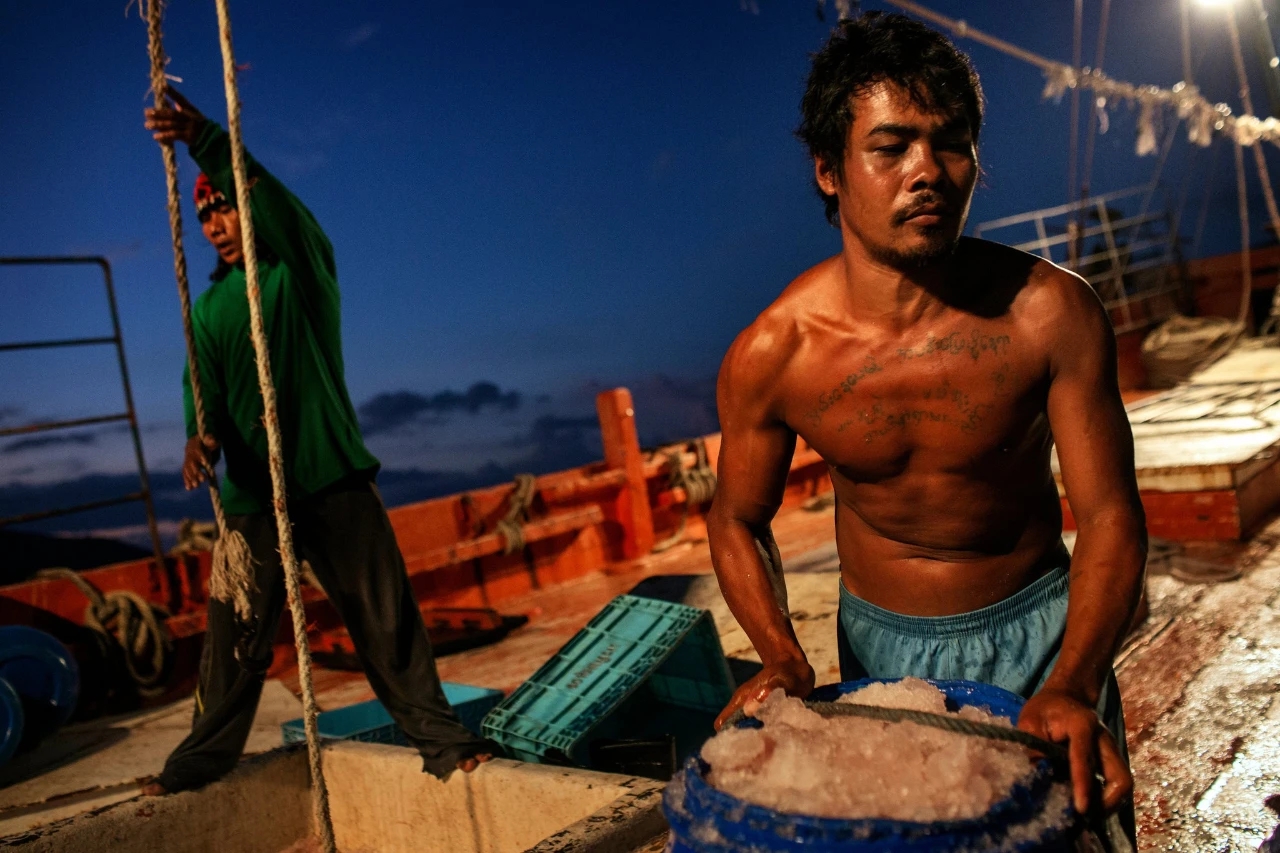 Image source: Adam Dean for The New York Times
Image source: Adam Dean for The New York Times
Evidently, overfishing directly leads to a drop in profit per unit, while costs double. As the fishing boats decrease, fishermen's wages dwindle along with it. In Thailand, young people are no longer willing to seek employment in the fishing industry, leading to a labor shortage of about 50,000 people [10]. Such a vicious cycle has created the perverse incentive to resort to human trafficking and this phenomenon of modern slavery.
When the fishing industry was more profitable, captains would pay large advance payments to their crews. Crews were at sea for years, and their families were able to support themselves with this money. However, as the labor crisis has worsened, this advance payment to the crew has been replaced by a "head payment" to cross-border traffickers [7].
And in distant seas, even fishing boats that have sailed to the international high seas are virtually beyond the reach of the law. It is even more difficult for the State to exercise jurisdiction, not to mention that Thai officials are often accused of accepting bribes to acquiesce in the passage of trafficked migrants across the border [7].
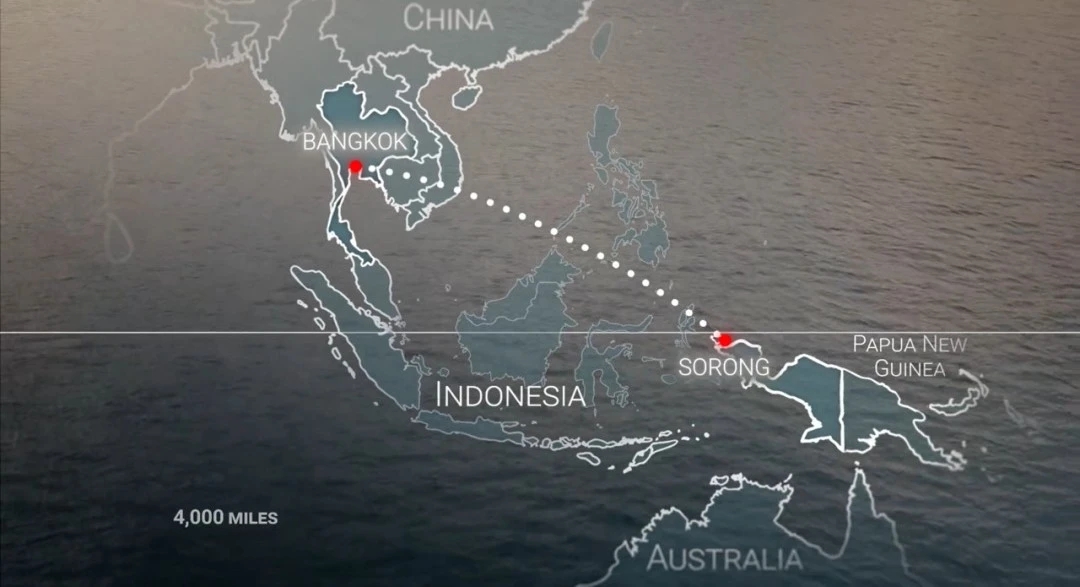
In the documentary, Patima and her companions from the Labour Protection Network (LPN) travel from Bangkok to South Indonesia, searching for fishery slaves who have successfully escaped from their boats and brought them back to Thailand or their homelands in Cambodia or Burma.
Once aboard a fishing boat, it's hard to escape.
In Thailand, only one out of every six fishing boats is recorded [11]. The other five are the ghost fleet.
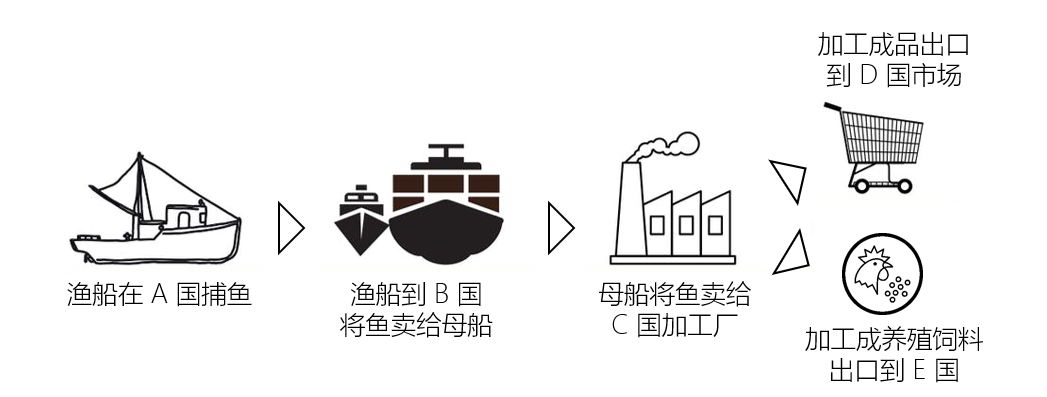
To take it a step further, what is the driving force behind overfishing?
We all understand the simple truth that big fish eat small fish and small fish eat shrimp. Because of overfishing, the ocean's vast expanse has been unable to satisfy the growing demand for "big fish," so fishing has turned to farming. In the farming system, to get a catty of "big fish" (500g), they require three to five catties of "small fish" (forage fish) as feed [12].
In addition to aquaculture, illegal fishing proceeds are widely used as feed for livestock such as poultry and pigs and to make canned foods for pets.
Your pampered pets may be eating the products of these fishing slaves.
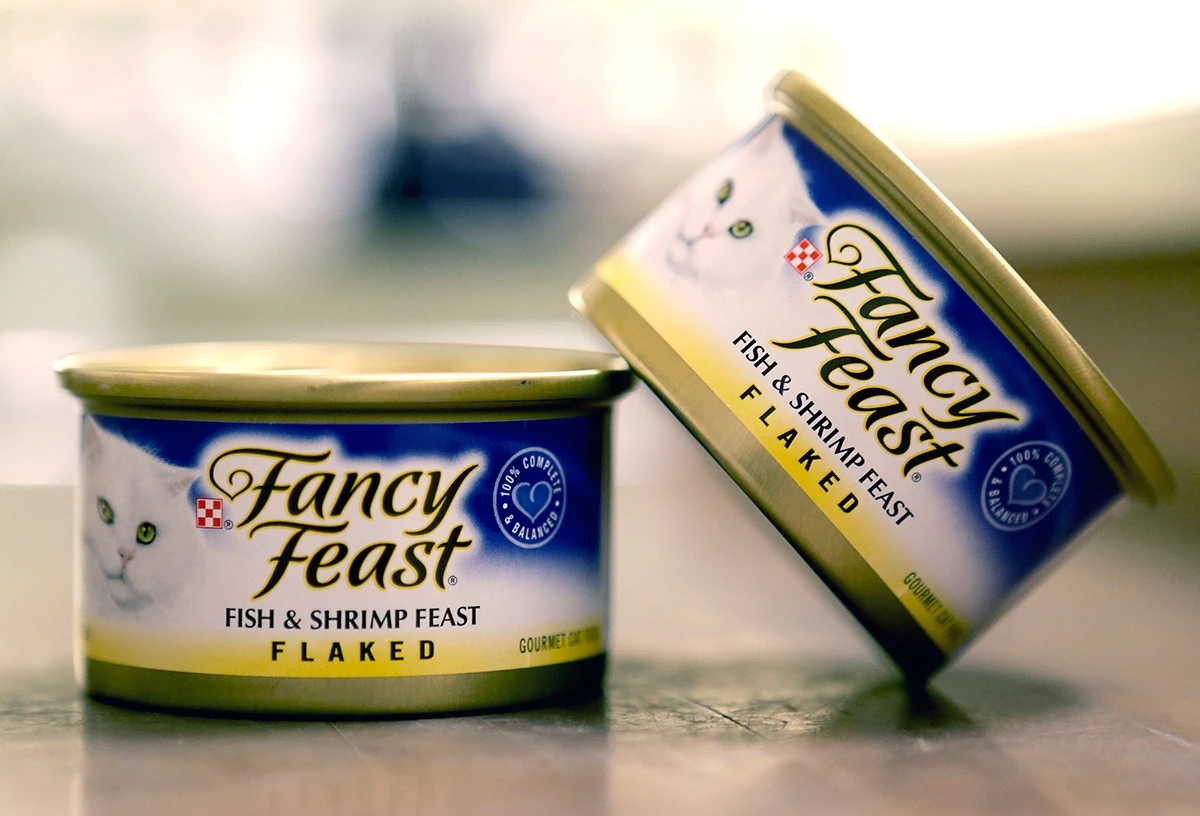
In August 2015, consumers filed a class-action lawsuit against Nestlé. They claimed that Nestlé violated consumer protection laws by failing to disclose ingredients in its cat food products that may have come from forced labor. This is just one of many related lawsuits against Nestlé.
Forage fish accounts for 37% of the total marine catch, 90% converted into fish meal and fish oil. In other words, one-third of the world's total catch is used for animal feed.
Under the globalized food system, modern slavery is not just a national problem.
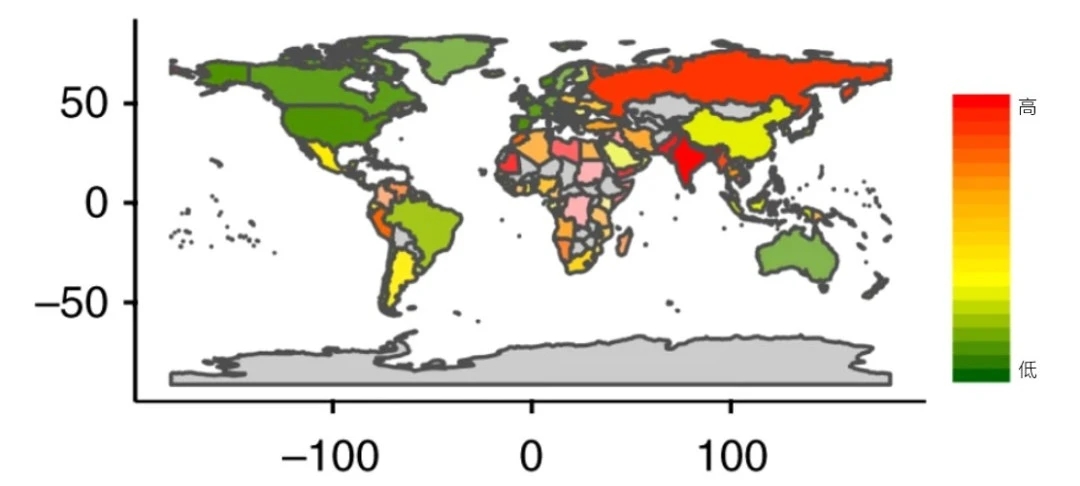
Status of modern slavery in the 20 largest fishing nations [14]
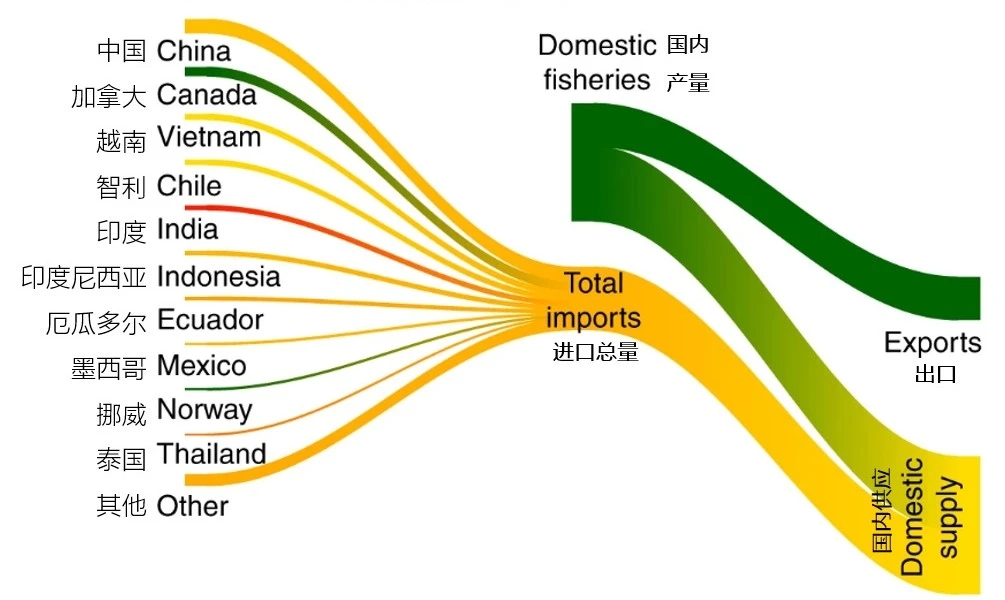
Status of seafood imports and exports in the US [14]
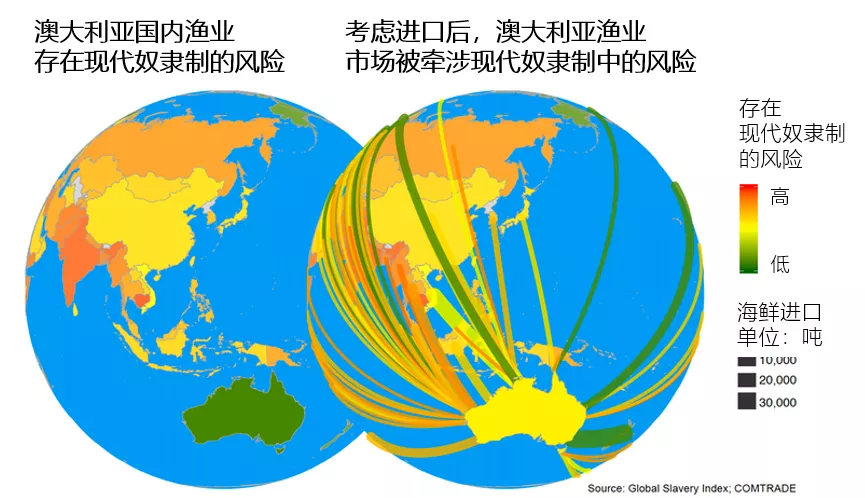
In Australia, for example, where large fish stocks have declined by 30 % over the past decade, and where the high prices offered for seafood, such as lobster and tuna, on the international market will continue to encourage exports. Therefore, increasing domestic production to meet its own demand and resorting to self-production is not a realistic option [15].
Greater international collaboration to combat illegal fishing is the accepted solution. Food companies must also improve the regulation and transparency of their supply chains.
This year's World Oceans Day theme is "Innovating for Sustainable Oceans", and innovativing technologies such as satellite data and artificial intelligence can be used to monitor the movements of fishing vessels to identify their suspicious behavior and help combat illegal fishing operations. Val Farabee, research director of Liberty Shared, an anti-human trafficking organization and researchers at the University of California, Santa Barbara, are further studying which patterns of fishing boats’ movements can help determine whether or not forced labor is occurring, which in turn provides direction for regulation and legislation [16].
We, as the consumer, cannot be disconnected.
Ultimately, human overconsumption of seafood drives overfishing. More than a billion people worldwide depend on the protein in seafood for their livelihoods, and many people who are already more vulnerable are bearing the brunt of the consequences of overfishing. The impact of the consequences of overfishing. Their basic food and nutritional security are sacrificed to pay for the unnecessarily high consumption of seafood in wealthy areas.
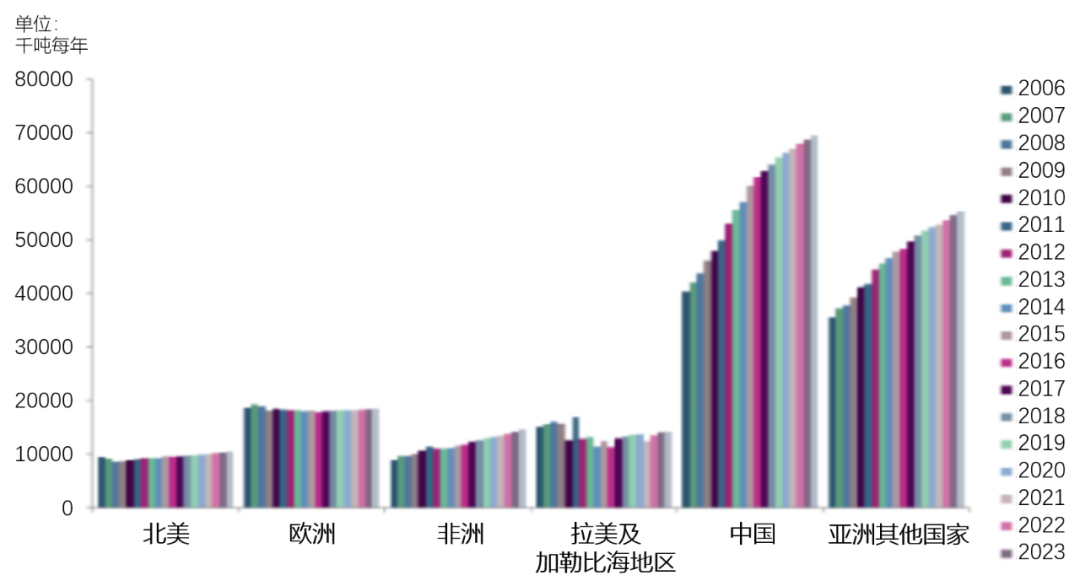
Global trends in fish consumption by region [17]
According to the Food and Agriculture Organization of the United Nations, in 2013, per capita consumption of aquatic products in China exceeded 96 grams per day.
The consumption of aquatic products by the Chinese population has already exceeded the upper limit recommended by the Dietary Guidelines [18] and is still growing rapidly. Two-thirds of China's aquatic production comes from aquaculture [19], which has made China a major consumer of fishmeal [20]. The capture of raw materials for the production of fishmeal is where the risks of modern slavery lie.
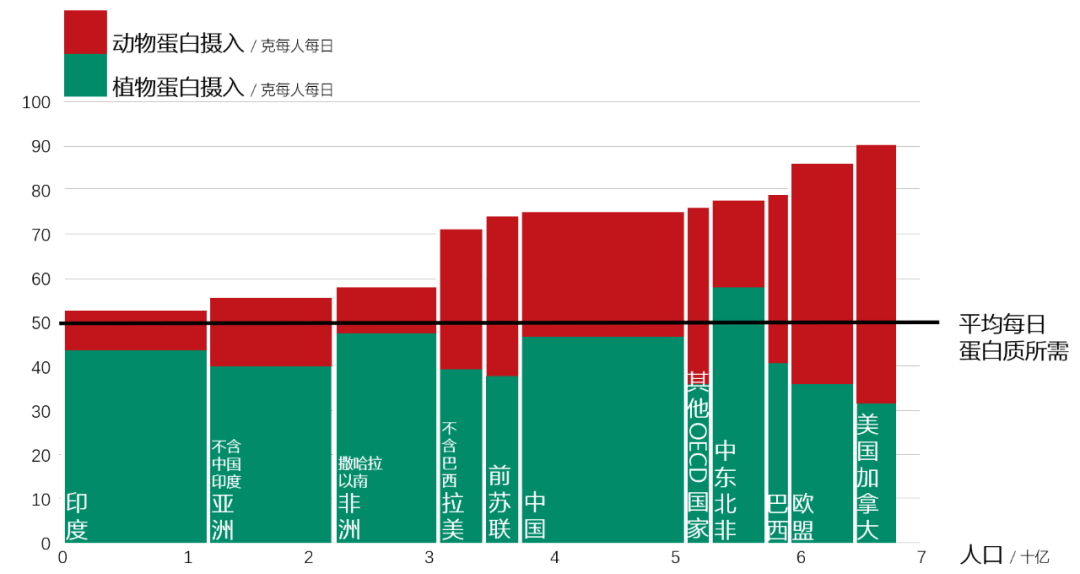
Global protein intake by region [21]
China's per capita protein intake is significantly higher than the rest of Asia, close to developed country levels and in a state of protein surplus.
Simply put, we can eat less of all types of fish and meat (and if you have a choice, primarily consume plant-fed meat).
In conjunction with the premise of consuming less, eating local, seasonal fish is not only better for one's health but also supports local fishing communities.
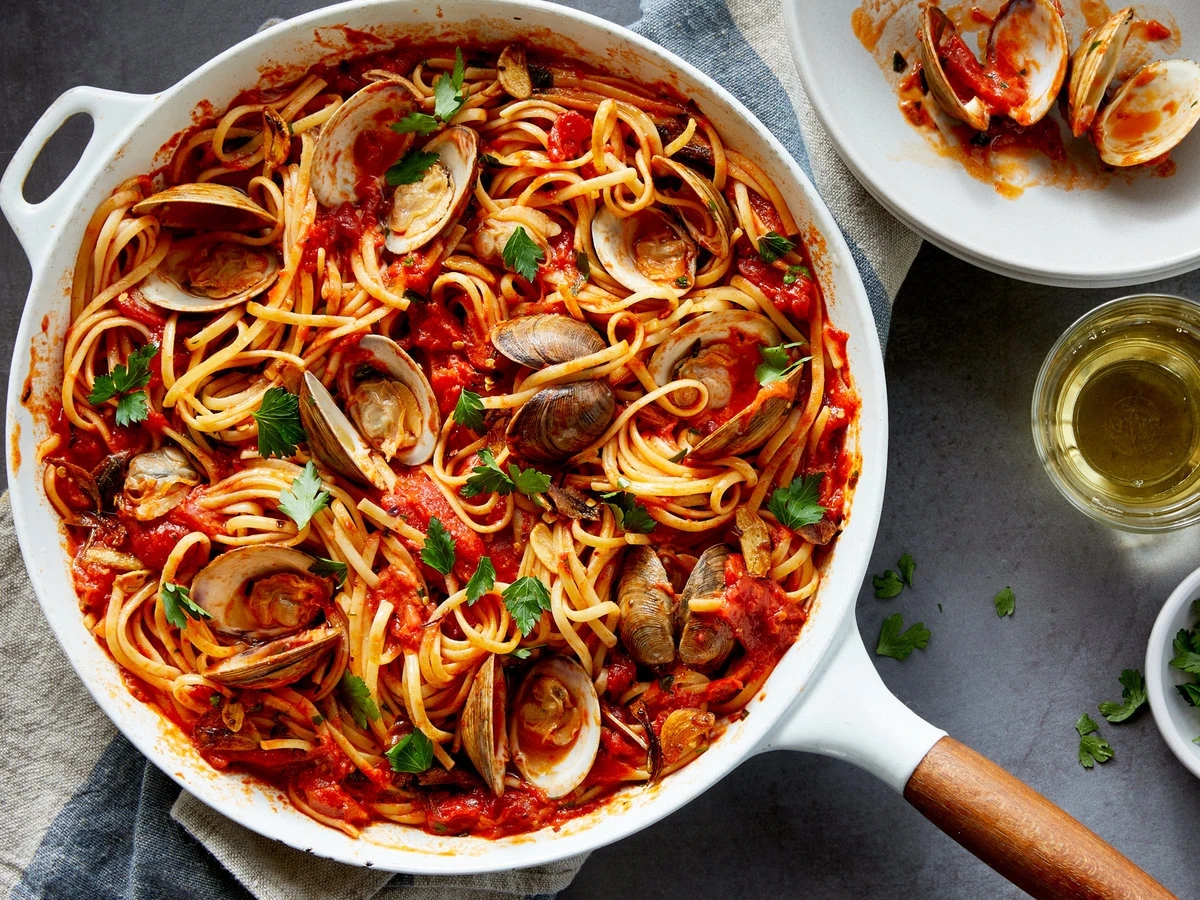 Photography: Antonis Achilleos Plate presentation: Rishon Hanners
Photography: Antonis Achilleos Plate presentation: Rishon Hanners
A "low food chain" diet can also significantly reduce stress on the environment and greenhouse gas emissions. Small amounts of forage fish can also be eaten directly, or bivalves such as clams, oysters, and other mollusks and insects. This diet also largely satisfies the body's need for vitamin B12 and other elements [22].
When purchasing seafood products, look for the presence of MSC (Marine Stewardship Council) or ASC (Aquaculture Stewardship Council). In March 2019, MSC updated its certification standards to ensure no forced labor or child labor in the supply chain of its certified products [23].
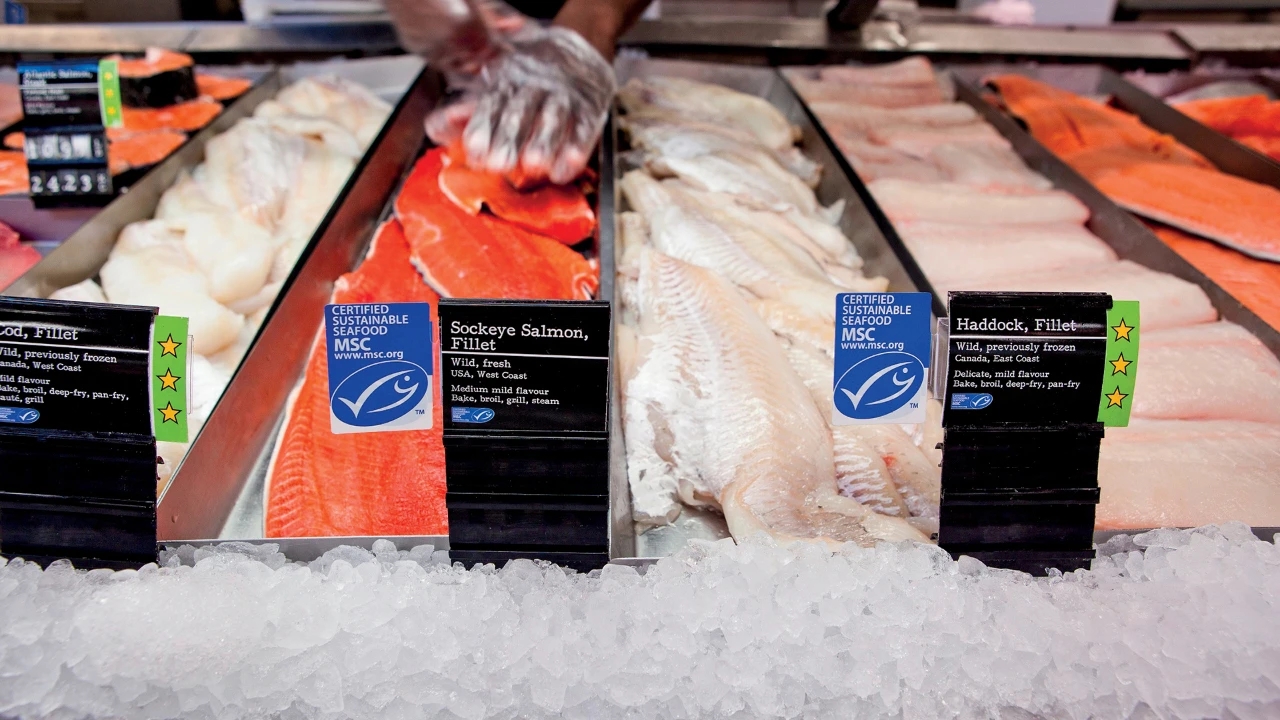
Image source: MSC
According to a recently published report, there are still few alternatives available, and the development of alternatives as a solution has not been taken seriously by mainstream marine conservation agencies [24].
Charoen Pokphand Foods, a global seafood giant that has been revealed to have fishery slaves in its supply chain, has started investing in plant-based meat. If investments in plant-based seafood are made over time, it may be possible to address the root causes of the lack of transparency in the supply chain and the difficulty of regulation.
At the end of the documentary, Pong, who had been enslaved for three years and also escaped from a fishing boat and was displaced for four years, was finally found in southern Indonesia by a team from the Labour Protection Network (LPN). After seven years, Pong returned to his family in Thailand.
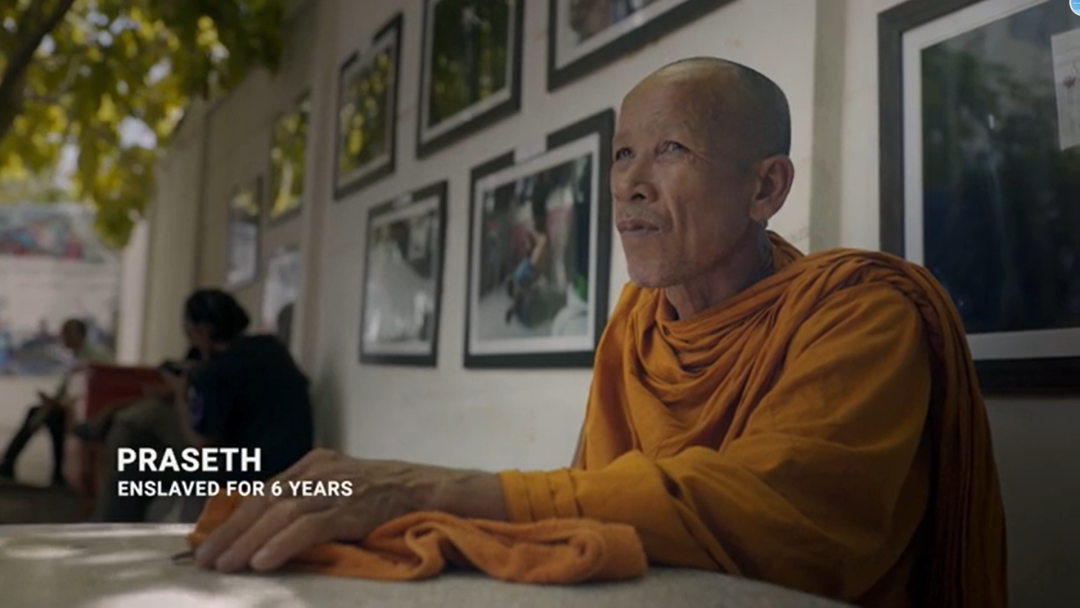
Pong had been on the same fishing boat as the previously rescued Praseth, who had been enslaved for six years and struck blind in one eye by the captain. Pong, as a witness, helped Praseth win his case and obtain compensation for his industrial injury.
Of the nearly 5,000 fishermen rescued by LPN, only a handful have received compensation.
Praseth later became a monk and prayed daily for the fishermen who died in front of him. And LPN continues to rescue many more workers still in bondage.
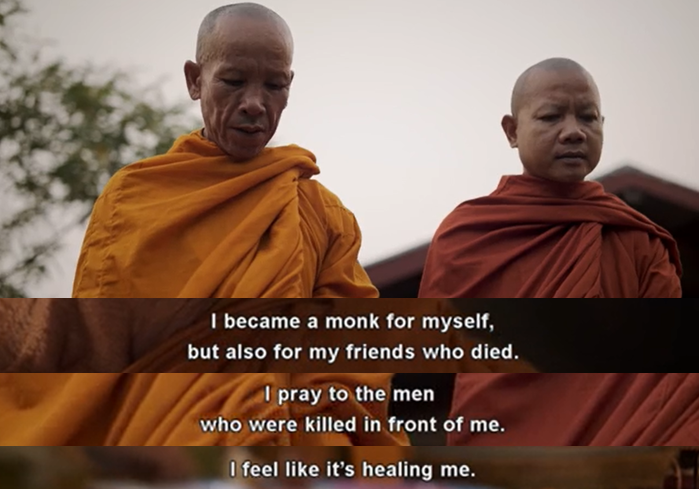
LPN's website states that seven out of every ten fishermen in Thailand may be in forced labor.
Deep beneath the sea, fish are trapped in fine nets; above the waves, people are trapped in dilapidated fishing boats. Nets are cast for profit, ensnaring fish unable to escape.. Like the fish, the people are trapped in the vast sea. Put down your knives and block the open mouths of the "big fish" so that they can swim back to their own blue sea.
Note
[1] FAO. The State of World Fisheries and Aquaculture 2000. 2000.
[2] FAO. Oceans crucial for our climate, food and nutrition. September 2014.
http://www.fao.org/news/story/en/item/248479/icode/
[3] Food Processing Technology. The ten most traded food and beverage commodities. Febuary 2014.
https://www.foodprocessing-technology.com/features/featurethe-10-most-traded-food-and-beverage-commodities-4181217/
[4] USDA Foreign Agricultural Service. Thailand Seafood Report. May 2018.
https://apps.fas.usda.gov/newgainapi/api/report/downloadreportbyfilename?filename=Seafood%20Report_Bangkok_Thailand_5-8-2018.pdf
[5] Department of Fisheries (Thailand). Thailand Fisheries Overview. November 2019.
https://www4.fisheries.go.th/index.php/dof_en/view_message/215
[6] International Justice Mission. Not in the same boat: prevalence & patterns of labour abuse across Thailand’s diverse fishing industry. July 2017.
https://www.ijm.org/thai-fishing-study
[7] Ian Urbina. 'Sea slaves': The human misery that feeds pets and livestock. July 2015.
https://www.nytimes.com/2015/07/27/world/outlaw-ocean-thailand-fishing-sea-slaves-pets.html
[8] Rainer Froese et al. What catch data can tell us about the status of global fisheries. Marine Biology, March 2012.
[9] FAO. The State of World Fisheries and Aquaculture 2018 - Meeting the sustainable development goals. 2018.
[10] Undercurrent News. Thai fishing industry in 'labor shortage'. Jan 2013.
https://www.undercurrentnews.com/2013/01/22/thai-fishing-industry-in-labor-shortage/
[11] Tracy Fernandez Rysavy. The Ghost Fleet.
https://www.greenamerica.org/world-hurt/ghost-fleet
[12] Deborah Zabarenko. One-third of world fish catch used for animal feed. October, 2008.
https://www.reuters.com/article/us-fish-food/one-third-of-world-fish-catch-used-for-animal-feed-idUSTRE49S0XH20081029
[13] G. Tyler Miller. Living in the Environment: Principles, Connections, and Solutions. 2007.
[14] Tickler, D., et al. Modern slavery and the race to fish. Nature Communications. 2018.
https://www.nature.com/articles/s41467-018-07118-9#citeas
[15] Jessica Meeuwig, et al. How to keep slave-caught seafood off your plate. November 2018.
https://theconversation.com/how-to-keep-slave-caught-seafood-off-your-plate-105861
[16] Sarah Gibbens. Slave labor is used to catch fish. This tech aims to stop it. June 2019.
https://www.nationalgeographic.com/environment/2019/06/slave-labor-used-to-catch-fish-but-tech-may-help/
[17] FAO.
[18] FAOSTAT. Food Supply - Livestock and Fish Primary Equivalent.
http://www.fao.org/faostat/en/#data/CL
[19] FAO. Fishery and Aquaculture Profile for China.
http://www.fao.org/fishery/facp/CHN/en
[20] FAO. GLOBEFISH - Information and Analysis on World Fish Trade. June 2019.
http://www.fao.org/in-action/globefish/market-reports/resource-detail/en/c/1199564/
[21] WRI. Sustainable Diets: What You Need to Know in 12 Charts. April 2016.
https://www.wri.org/blog/2016/04/sustainable-diets-what-you-need-know-12-charts
[22] Brent F. Kim, et al. Country-specific dietary shifts to mitigate climate and water crises. Global Environmental Change. September 2019.
https://clf.jhsph.edu/publications/country-specific-dietary-shifts-mitigate-climate-and-water-crises
[23] MSC. New measures introduced to combat forced and child labour in seafood businesses. March 2019.
https://www.msc.org/en-us/media-center/news-media/new-measures-introduced-to-combat-forced-and-child-labour-in-seafood-businesses
[24] 谷孚咨询. 【深度报告】植物基与细胞培养海鲜替代品会迎来哪些独有的机遇和挑战?June 2020.
https://mp.weixin.qq.com/s?__biz=MzIwNzU0NjU2Nw==&mid=2247484029&idx=1&sn=ac90dada8d5f29b3e08c2f3f05dcc69a&chksm=9711f3d5a0667ac379601083216ca9ec311a1b9b936a7f37fbd86f3149032e35cb7c3cd4677f&token=1687950315&lang=zh_CN#rd